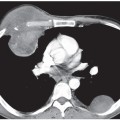CASE 102 84-year-old woman trapped in a house fire two and a half weeks earlier with burns over 30% of total body surface area, ongoing hypoxia, and inability to be weaned from ventilator support AP chest exam (Fig. 102.1A) shows heterogeneous, multi-focal, primarily peripheral, patchy air space opacities and consolidations throughout both lungs. A mid-line tracheostomy and left upper extremity PICC are seen. Sequential unenhanced CT images through the upper, mid, and lower lung zones (lung window) (Figs. 102.1B, 102.1C, 102.1D, 102.1E, 102.1F) demonstrate patchy, multi-focal ground glass opacities and areas of crazy paving in non-dependent lung, areas of more frank consolidation in dependent lung, and intervening areas of normal lung. Bronchial and bronchiolar dilatation is seen in some foci of affected lung. Note the dependent layering bilateral pleural effusions. Diffuse Alveolar Damage (DAD) with Acute Respiratory Distress Syndrome (ARDS) • Aspiration Pneumonia • Various Heath Care–Related or Ventilator-Acquired Pneumonias • Other Causes of Non-Cardiogenic Pulmonary Edema • Diffuse Alveolar Hemorrhage Diffuse alveolar damage (DAD) is a form of acute lung injury that progresses through two and sometimes three phases. The exudative (acute) phase occurs during the first week after the onset of lung injury and is characterized by damage to type 1 pneumocytes and endothelial cells with exudation of plasma proteins into the alveolar interstitium and spaces. The proliferative (organizing) phase begins at the end of the first week after lung injury, during which time the inflammatory exudate organizes and there is extensive proliferation of type 2 pneumocytes and fibroblasts. The fibrotic (chronic) phase develops in patients who survive three to four weeks on a ventilator and is characterized by extensive lung remodeling by dense fibrous tissue. The clinical syndrome associated with DAD histology is the acute respiratory distress syndrome (ARDS). ARDS is associated with a wide array of precipitating clinical events (Table 102.1). More than 60 possible causes of ARDS have been identified and the list continues to grow. The most common risk factor for ARDS is sepsis. The most common direct lung injury associated with ARDS is aspiration of gastric contents. Several factors increase the risk of ARDS after an inciting event: advanced age, female sex (only in trauma patients), cigarette smoking, and alcohol use. For any underlying precipitant, increasingly severe illness as predicted by a severity scoring system (e.g., Acute Physiology and Chronic Health Evaluation [(APACHE)] increases the risk of ARDS.
 Clinical Presentation
Clinical Presentation
 Radiologic Findings
Radiologic Findings
 Diagnosis
Diagnosis
 Differential Diagnosis
Differential Diagnosis
 Discussion
Discussion
Background
Etiology
Stay updated, free articles. Join our Telegram channel

Full access? Get Clinical Tree





